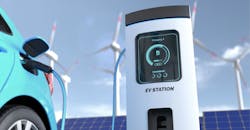As electric utilities and grid operators across the United States grapple with the sudden arrival of rising electricity demand, they’re seeking solutions to maintain reliability while managing costs by avoiding or deferring expensive infrastructure investments.
Increasingly, utilities are turning to demand-side management as the best option for maintaining reliability and affordability. Their customers’ adoption of distributed energy resources (DERs), such as rooftop solar, battery energy storage systems (BESS), and smart devices like thermostats and water heaters, has handed utilities a golden opportunity at the grid’s edge to meet the challenge of rising electricity demand.
However, they need a plan to optimize these customer-owned, behind-the-meter DERs and flexible loads together to unlock their full value.
Vehicle electrification offers the perfect example at the grid’s edge. As electric vehicle (EV) adoption rises, utilities have seen an increasing number of requests to connect public EV charging infrastructure. Because charging station developers want to maximize usage and revenue, they plan to install chargers in high-traffic, high-population areas. However, EV charging has a high peak load, and many ideal locations for charging stations already face electric grid constraints. Requests to connect new charging stations to the grid often result in long interconnection waits, costly grid upgrade fees, or outright rejection.
In this scenario, there is an opportunity for charging infrastructure developers and electric utilities to optimize DER-flexible load to manage grid congestion and address the increase in energy demand, leading to a win-win outcome.
With the addition of DERs, such as solar and a BESS, to a public charging infrastructure project, developers can bring their projects online while helping utilities avoid or defer grid upgrades. By using the BESS to shift EV charging demand from peak grid demand hours to off-peak hours, the charging stations can limit the stress they add to the grid. The solar and storage energy supply can further be used as a resource for the grid during periods of high stress, turning them into local distribution grid assets. In short, smart EV charging strategies with the integration of solar and storage transform EVs from an unpredictable load for utilities into controllable assets.
By optimizing onsite solar, BESS, and EV charging together, utilities and project developers maximize load flexibility and financial value.
In some service territories, many incentives and programs are already in place to create the financial value customers need to offer their energy resources as grid assets. Elsewhere, utilities can collaborate with regulators, policymakers, and market operators to establish the framework for implementing necessary programs. Some of the most common value-creating opportunities utilities provide to incentivize the use of customer DERs and loads as grid assets are:
- Demand response programs
- Energy market participation to allow customers to capture energy arbitrage opportunities
- Participation in capacity auctions
- Payments to customers for the provision of ancillary grid services, emergency services, and other services
DER and Flexible Load Optimization in Action
In New England, one state is in the process of overhauling many of its travel plazas, and one of the key initiatives is to install DC fast-charging stations at plazas. Electric Power Engineers (EPE) partnered with the state to identify locations that would deliver the highest use and most revenue for the EV chargers.
As part of the analysis, EPE found that the busier a travel plaza was, the less electric grid capacity was available to interconnect additional assets like EV chargers. EPE developed an optimization model to evaluate how co-locating solar DERs and BESS with EV charging stations, plus leveraging available demand-side management programs and state incentives, could maximize project value. The model identified strategies that aligned EV charging load profiles with grid capacity constraints, helping avoid costly infrastructure upgrades. The results showed a clear path to solve grid constraints and preserve financial upside for project developers. The idea of a win-win scenario proved to be a reality.
In a western state, EPE conducted a resource optimization study to support the deployment of public EV charging infrastructure without triggering costly grid upgrades. Recognizing the local utility’s hesitation to upgrade substations and transformers in the near term, the EPE team evaluated how a strategically sized BESS could address EV charging demand while mitigating grid constraints. The analysis identified the optimal BESS capacity and control strategy to help defer grid infrastructure investments and maintain system reliability, enabling a more cost-effective and scalable approach to transportation electrification. Installing the BESS instead of upgrading the substation saved the utility a significant capital expenditure.
Unlocking the DER-Flexible Load Optimization Value Requires Careful Planning
There’s an old cliche in business that goes: You don’t know what you don’t know.
In the case of DERs and flexible loads, utilities and project developers often don’t account for the value that on-site energy optimization offers them because they don’t know that the value exists. Utilities can stay ahead by partnering with trusted experts who can evaluate site-specific load growth, assess local grid capacity and constraints, and optimize DER system capacities and designs. Making that up-front investment unlocks revenue and cost-saving opportunities that account for the financial and operational realities of local grid infrastructure.
Analysis unlocks value, and utilities evaluating new large load requests should understand the value they could harness from DERs and flexible loads optimized together to solve grid challenges.
Sponsored By:
About the Author

Fahad Rashid
Manager – Electrification, Electric Power Engineers
Fahad Rashid is a seasoned energy and utility professional with over 14 years of experience driving innovation and execution across North America's evolving energy landscape. With a strong engineering foundation, he excels at bridging technical and business domains to deliver integrated, scalable solutions in transportation and building electrification, demand response, energy efficiency, distributed energy resources (DERs), and grid modernization. Fahad has played a pivotal role in designing and managing regional pilot programs for DERs and led revenue metering initiatives that shaped utility innovation. His expertise spans the full project lifecycle, from feasibility and design to commissioning, for solar, wind, and storage projects, while ensuring regulatory compliance and technical excellence.
Well-versed in stakeholder engagement, Fahad has facilitated numerous collaborative sessions with public and private partners, including regulators, renewable developers, and grid operators. His ability to navigate regulatory frameworks and market dynamics enables him to align complex technical programs with broader policy and economic goals. Throughout his career, Fahad has consistently delivered results in project management, technical design, program development, client engagement, and proposal development. He brings a collaborative approach to working across cross-functional teams and senior leadership, ensuring timely, cost-effective, and high-quality project outcomes. With a strong reputation for clarity in communication and operational execution, Fahad is a trusted advisor in the advancement of decarbonization and distributed energy strategies.


